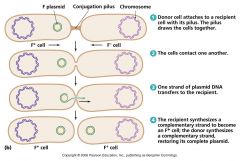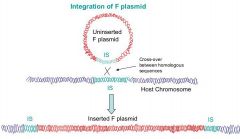![]()
![]()
![]()
Use LEFT and RIGHT arrow keys to navigate between flashcards;
Use UP and DOWN arrow keys to flip the card;
H to show hint;
A reads text to speech;
32 Cards in this Set
- Front
- Back
|
What confirmed the physical union of bacteria in conjugation? |
Microscopic studies have confirmed the physical union of bacteria,called conjugation. During conjugation, the donor cell transfers someof its genetic information to a recipient cell. |
|
|
How is genetic information transferred? |
Genetic information is transferred through a hollow tube made ofproteins, called a conjugation pilus or conjugation tube or sex pilus |
|
|
What is the F plasmid? |
Initially called the fertility factor the F plasmid of E. coli was the first plasmidto be discovered. F plasmid carries genes which enable genetic exchangeby conjugation. |
|
|
What are the features of the F plasmid? |
The F plasmid is 100 kb in size and has the following features 1. Approx. 30 transfer (tra) genes 2. An origin of replication (oriV) 3. An origin of transfer (oriT). 4. Three insertion sequences (IS). |
|
|
How does the transfer of the F plasmid by conjugation work? |

|
|
|
What is the first step in the conjugation? |
1. The F+ cell has a conjugation pilus that attaches to the F- celland retracts drawing the cells closer together and forms a tube made ofpilin proteins through which the F plasmid can transfer. |
|
|
What is the second step in the conjugation? |
2. A single strand copy of the F plasmid is transferred from the F+ cell into theF- cell. Prior to transfer a single strand nick is produced at oriT in the F plasmidby the relaxosome (protein complex). A single strand of the F plasmid DNA calledthe T strand is transferred to the F- cell. |
|
|
What is the third step in the conjugation? |
3. The DNA replication process ensures that both copies of the F plasmidbecome intact circular double stranded DNA molecules. Each cell now hasa F plasmid and is referred to as F+. |
|
|
How long does the transfer of the F plasmid take? |
It takes 2 minutes for the F plasmid to transfer into the F- cell. |
|
|
How many cells in an E.coli cell culture will have the F plasmid integrated into their genome? |
1 in 100,000 cells in an E. coli cellculture of F+ cells will have the Fplasmid integrated into the genome. |
|
|
What are the E.coli cells that have a copy of the F plasmid in their genome known as? |
E. coli cells which have a copy of theF plasmid in their genome are knownas Hfr strains. Hfr for high frequencyof recombination |
|
|
When will the F plasmid integrate? |

The F plasmid integrates when ahomologous recombination eventoccurs between one of its ISsequences and one of the many ISsequences on the E. colichromosome. |
|
|
How can the bacterial chromosome be mobilised? |
The bacterial chromosome canbe mobilised by the integratedF plasmid. A Hfr cell can conjugate with a F cell. Bacterial DNA flanking the integrated F plasmid is transferred across into the F- or recipient cell. |
|
|
How long would it take to transfer the entire E. coli chromosome? |
It would take 100 minutes to transfer the entire E. coli chromosome. |
|
|
What normally happens to interrupt the transfer? |
The mating pair of E. coli usually break apart before the wholechromosome is transferred. |
|
|
What does the recipienr (F-) cell become? |
The recipient (F-) cell remains F- (as it never receives all the Fplasmid). |
|
|
What must the transferred linear DNA do to survive? |
For the transferred linear DNA to survive it must integrate intobacterial chromosome by homologous recombination as it has nomechanism to replicate itself independently |
|
|
What is the procedure of mapping the E. coli chromosome by interrupted conjugation (mating) based on? |
The procedure is based on the artificial interruption of conjugationbetween Hfr and F- cells. In each mating a number of selectablemarkers are chosen for analysis at each time point |
|
|
What are these selectable markers? |
gal- unable to use galactose as a carbon sourcelac- unable to use lactose as a carbon sourcetonS sensitive to colicin and T1 phage aziS sensitive to azide strS sensitive to antibiotic streptomycin |
|
|
What are colicins? |
Colicins are proteins produced by E. coli containing ColE1 plasmids which bindreceptors in the cell envelope and cause cell lysis. |
|
|
In the example what strains are mated? |
The two stains mated in this example are Hfr strain strS gal+ lac+ tonR aziR F- strain strR gal- lac- tonS aziS |
|
|
What happens at time 0? |
At time 0 the Hfr and F- cells are mixed together |
|
|
What happens after 5 mins? |
After 5 minutes a sample of the cells is taken out, vortexed to breakthe cell-cell contact and plated on the selective media |
|
|
What selective media are used? |
Minimal media with streptomycin and lactose (lac+) Minimal media with streptomycin and galactose (gal+) Minimal media with streptomycin and azide (aziR) Minimal media with streptomycin and colicin (tonR) Samples of cells are removed at 10, 15, 20, 25 minutes etc. andplated on the same set of selective media plates. |
|
|
What is the aim of the process? |
The aim is to find the time the selectable marker gene is first transferred intothe strR F- cell. The first genetic maps of E. coli were constructed using thismethod. |
|
|
Where can the F plasmid integrate into the E.coli genome? |
The F plasmid can integrate into different sites (IS sites) in the E. coligenome creating different Hfr strains. They can also integrate in the sameIS site in the E.coli genome in two different orientations. |
|
|
How can a more detailed circular map of the positions of genes in the E.coli genome be created? |
Different Hfr strains of bacteria were the F plasmid has integrated intodifferent sites and in different orientations in the E. coli chromosome havebeen used to produce a genetic map of different parts of the E. coli genomeusing the interrupted mating technique. By overlapping these linear maps itis possible to create a more detailed circular map of the positions of genesin the E. coli genome. |
|
|
What do you need to be aware of when using naturally occurring plasmids? |
Since the discovery of the F plasmid in E. coli thousands of naturally occurringplasmids have been isolated from many different types of bacteria Note 1. Only some naturally occurring plasmids can transfer between bacteria 2. Only some naturally occurring plasmids can integrate into the bacterialgenome |
|
|
What are R plasmids? |
R plasmids are a group of plasmids found in a range of bacterial speciesthat a. have tra genes so can conjugate between different species of bacteria b. carry genes that confer multiple antibiotic resistancec. Large ~ 100 kb |
|
|
What are CoIEI plasmids? |
ColEI plasmid found in E. coli a. small (6.6 kb) and does not carry tra gene cluster so can NOT move byitself between different bacteria. b. carries ColEI gene that produces a protein colicin which is excreted formthe cell and toxic to other bacteria (not the host). |
|
|
What are Ti plasmids? |
Found in soil bacteria Agrobacterium tumefaciens a. Large (~ 200 kb) have tra genes so can conjugate between differentspecies of bacteriab. Also able to transfer the T-region of plasmid into plant cells. c. Integration of T-region into plant chromosomes causes crown galldisease. |
|
|
What do transfomation, transduction and conjugation allow? |
Transformation, transduction and conjugation allow bacteria toexchange DNA between each other.Can be same species of bacteria or different species |

